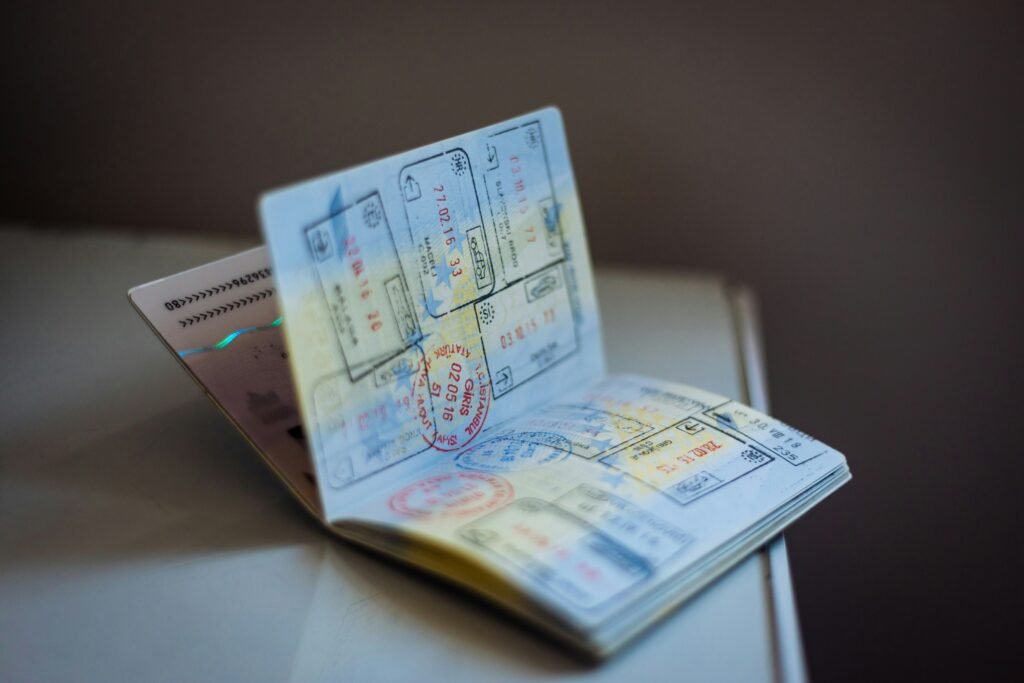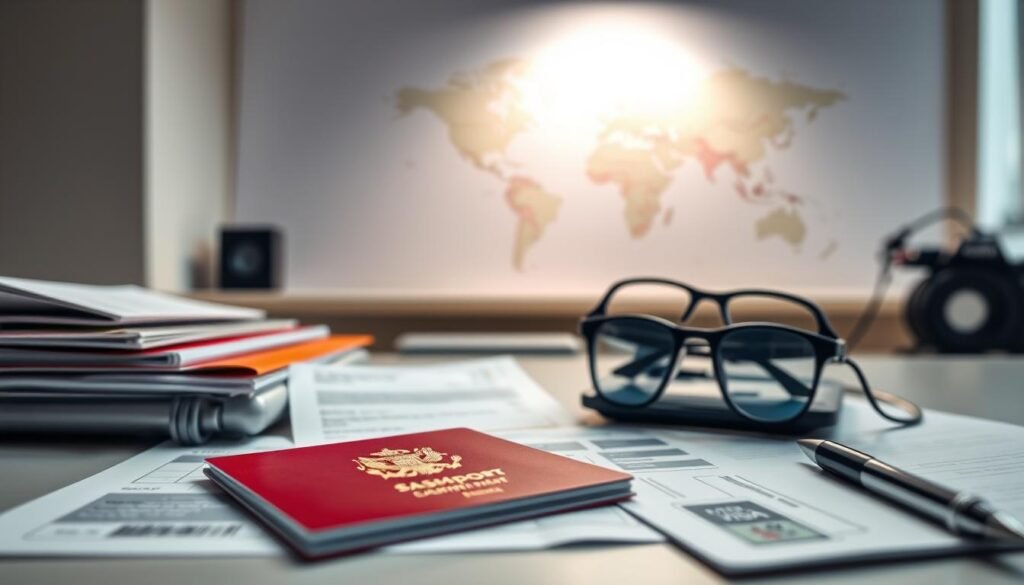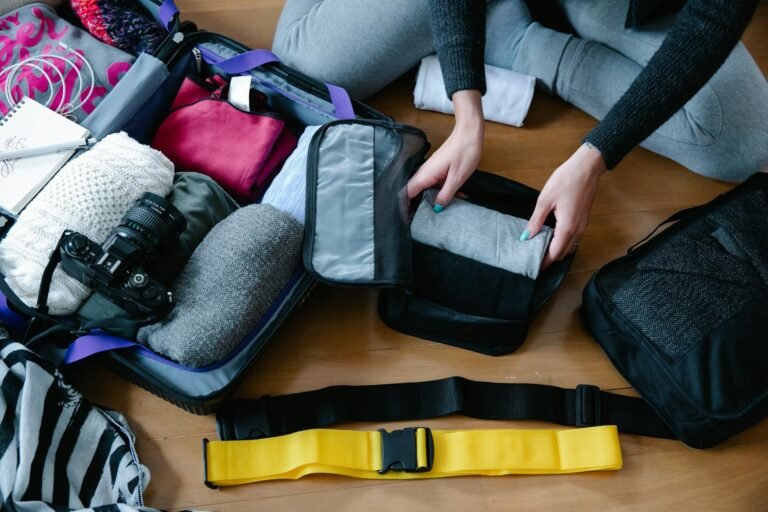Did you know the Schengen Area now spans 29 countries? Yet, one small sticker can grant access to all. If you’re planning a trip to Europe, knowing if you need a visa is key. It saves you time, money, and stress.
I’ve helped many travelers get their schengen travel visa on a tight budget and schedule. The same seven steps work every time. In this guide, I’ll show you how to apply for a schengen visa confidently. You’ll learn about the 90/180-day limit, what documents you need, and how to avoid last-minute problems.
Discover where to file your eu visa and how long it takes to process. You’ll also see why insurance of at least €30,000 is essential. I’ll warn you about EES changes and ETIAS coming in 2025. This way, you can ensure your visa approval doesn’t ruin your trip.
When you’re ready, start your application on the Tourow Visa page. This will help you submit the right forms and track your application. I’ll guide you every step of the way, so your plans stay on track and within budget.

The Short List
- One visa opens border-free travel across 29 Schengen countries—plan your route before you file.
- File with the consulate of your main destination, or first entry if time is split evenly.
- Insurance must cover at least €30,000 for emergency care, hospitalization, and repatriation.
- Expect biometrics and an in-person appointment; book early during peak seasons.
- Understand the 90/180-day rule to avoid overstays across multiple trips.
- Track your file through consulate or outsourcing portals and double-check your visa sticker.
- EES is rolling out now and ETIAS is expected in 2025—budget extra time at the border.
Understanding the Schengen Area, Visa Rules, and the 90/180-Day Limit
I start every trip plan here because it sets up everything else. The Schengen Area covers 29 countries with one external border and shared checks. Once you clear the first entry, you can travel between France, Italy, Germany, Spain, and more without internal passport control. It feels seamless—and it is—when you know the schengen visa requirements and your route.

What the Schengen Area is and how border-free travel works
Think of Schengen as a single travel zone. You enter through one member, then move to others without routine checks. Airlines and rail staff may verify ID at gates, but immigration happens only at the external border. I keep my passport handy for hotels or spot checks.
Who needs a visa and when short trips may be visa-free
Here’s my rule of thumb: if your passport has visa-free access, your short trip can be easy. If not, you’ll apply for an eu visa under the standard schengen visa requirements. Many travelers ask, do i need a schengen visa for a week in Paris or a conference in Berlin? It depends on your nationality and purpose.
Some visitors can enter visa-free for tourism or short business meetings, but work or longer stays require a visa. Always confirm europe visit visa requirements before you book.
How the 90/180-day rule is calculated for multiple trips
The 90/180 rule rolls. Count back 180 days from today, add up all days you were in Schengen, then include your next trip. The total must not pass 90 days. I log entries and exits after each flight to avoid an accidental overstay.
To double-check my math, I use the European Commission’s calculator linked from this government resource: Schengen travel guidance.
- Day count starts at midnight of arrival and includes your departure day.
- Multiple short trips stack up fast—track every weekend hop.
- If you hit 90 days, wait outside Schengen until the balance resets.
Non-Schengen EU countries to note (e.g., Ireland, Cyprus)
Not every EU country is in Schengen. The Republic of Ireland and Cyprus run their own border rules. Time spent there does not reduce your Schengen allowance. When I mix Dublin or Nicosia into a route, I plan separate entry rules while keeping the 90/180 clock clean for Schengen days.
This helps align europe visit visa requirements with your actual path and avoids surprises at the next border check.
schengen travel visa Requirements and Documents to Prepare
I keep things simple by organizing all my documents in one folder. I check the visa requirements on the consulate’s website before printing. This helps me avoid last-minute stress and catch any missing documents early.
If I’m unsure about any rules, I check the official EU visa policy page. This page has a quick guide to Schengen visa application. It ensures my documents meet the real requirements.

Passport validity, application forms, and compliant photos
First, I check my passport. It needs to be valid for at least three months after I leave the Schengen area. I also make sure it has enough blank pages. Then, I fill out the application form and add photos that follow ICAO standards. These are the basic documents needed for visa checks.
- Passport: validity + empty visa pages
- Completed application form
- ICAO-compliant photos (recent, identical)
Papers needed for Schengen visa: travel itinerary and accommodation
Next, I prepare proof of my travel plans and where I’ll stay. I book refundable flights and hotels that match my itinerary. If I’m staying with friends or family, I include a signed invitation and their ID when needed.
- Flight bookings or reservations
- Hotel confirmations or rental agreements
- Invitation letter if hosted, when applicable
These documents help show a clear plan and meet the visa requirements for the purpose and length of my stay.
Proof of sufficient funds and purpose of travel
I need to show I have enough money for my trip. I provide recent bank statements, pay stubs, or an employer letter. If I’m self-employed, I add business bank statements and registration.
- Bank statements from recent months
- Employment or freelance proof (pay stubs, letters, registrations)
- Purpose evidence: day-by-day tourism plan, conference registration, business invite, medical appointment, or study letter
This set of documents proves I have enough money and a valid reason for my trip.
Travel insurance minimums: at least €30,000 medical coverage
Travel insurance is a must. I buy a policy that covers all Schengen states for my entire stay. It must have at least €30,000 for emergency medical, hospitalization, and repatriation. Companies like AXA and UK-based options such as Gigasure offer suitable plans.
- Coverage: €30,000 minimum, multi-country, trip-long
- Certificate listing insured traveler, dates, and territory
Before I submit, I check the consulate’s checklist carefully. I add any extra letters and make sure my documents are complete and meet the visa requirements.
How to Apply for Europe Visa from the United States
I’ve applied for visas from New York to Los Angeles. The process is easier when you know what to do. To apply for a Europe visa from the U.S., start early and stay organized. Whether you apply online or in person, the steps are the same.

Identify the correct consulate based on main destination or first entry
For a schengen visa from usa, choose the consulate of your main destination. If your trip is split, pick the consulate of the first country. This ensures your application is handled correctly and avoids delays.
Check each mission’s rules on their website. France, Germany, Italy, Spain, and others use platforms like VisaHQ or VFS Global for appointments. Some take applications directly. This affects where you submit and how fast you get a slot.
Step-by-step guide: check requirements → prepare documents → book appointment / submit application → pay fees → wait for processing
- Check requirements: read the consulate page for your route and note photo specs, form versions, and processing windows.
- Prepare documents: passport, forms, photos, itinerary, lodging, insurance, proof of funds, and proof of purpose.
- Book appointment or submit via the authorized visa center, then confirm your time and location.
- Pay fees as instructed, and save the receipt.
- Wait for processing, using your tracking reference for updates.
If you also plan short visa-free trips later, skim this guide to ETIAS for American travelers. This way, you know when authorization applies and how long it stays valid.
Schengen visa application from USA and timing considerations
A schengen visa application from usa moves smoother when you plan ahead. I aim to file at least four to six weeks ahead for spring and summer. For winter holidays, I push even earlier.
If you need clarity on how to get a schengen visa from usa, remember each consulate posts lead times. Apply for schengen visa slots can vanish fast before June and December, so set alerts and check daily.
Visa fees, biometrics, and appointment day tips
Most travelers must give biometrics—fingerprints and a facial image—every 59 months. Bring your passport, copies, and your printed checklist. I dress neatly, arrive 15 minutes early, and keep documents sorted in a clear folder with tabs.
- Fees vary by consulate and can change; follow the current rate and payment method.
- Review entries and validity on approval to match your itinerary and any side trips.
- Keep your tracking number handy until your passport is back in hand.
When I coach friends on how to apply for europe visa steps, I stress calm, concise answers and consistency across forms, bookings, and bank statements. These small habits make your schengen visa from usa application look professional and complete.
Timeline and Processing: What to Expect and How Long It Takes
I plan my trip backward to avoid last-minute stress. Each consulate has its own pace, and the application timeline changes with the seasons. Summer and holidays are busier, so I add extra time to my plans.

How long does it take to apply for Schengen visa and get a decision
For short stays, you can’t apply too early. I find out the earliest you can apply and book an appointment. Then, I wonder how long it takes to apply and get a decision at my chosen consulate.
Applying involves filling out forms, giving biometrics, and waiting. Processing times vary from a few days to weeks. If you’re worried about delays, plan ahead to avoid missing your flight.
Schengen visa application timeline and seasonal delays
During peak times, June to August and late November to January, things slow down. The application timeline gets longer. Appointments fill up quickly during these periods.
- Book the earliest available appointment without cutting it close.
- Account for EES border lines adding time at departure and arrival.
- Keep your itinerary flexible until your passport is back.
Friends often ask about summer delays. I tell them to plan weeks in advance. The same advice applies for holidays.
Tracking your application status and reading your visa sticker
After applying, I track my status online. Updates are brief, so I keep my receipt number ready.
When my passport returns, I check the visa sticker carefully. I make sure it matches my travel plans. If plans change, I know extensions are rare. I stick to my original dates.
Before buying tickets, I consider everything. I think about the application time, any delays, and the buffer I need. This way, I’m prepared for any unexpected delays.
Travel Insurance and Financial Proof to Strengthen Your Case
I always make sure my Schengen application is strong with solid insurance and finances. This makes it easier to meet the requirements and speeds up the process. If you’re wondering how to get a Europe visa, start by building a solid file.

Why travel insurance is a must
Consulates want to see a policy that covers medical needs in all Schengen states for your trip. I pick plans that fit these rules, like AXA’s Schengen options. Gigasure’s high limits and 24/7 help also give me peace of mind.
If you travel often, an annual plan is a smart choice. It saves money and shows you’re well-prepared, which helps your application.
Coverage scope: emergency care, hospitalization, repatriation
- Emergency medical treatment: At least €30,000, no gaps across countries.
- Hospitalization: Direct billing when possible, plus clear policy wording.
- Repatriation: Medical evacuation and return of remains included.
I also look for extra coverage like trip cancellation, delays, and baggage. These aren’t required but protect your budget if plans change.
Using bank statements and employment letters for means of subsistence
Financial proof is key. I include recent bank statements, pay stubs, and an employment letter. For self-employed, I add business statements and registration. This shows a steady income.
- Match dates on flights, hotels, and deposits to your statements.
- Keep balances above the daily target for your stay and destination.
- If sponsored, attach a signed letter plus the sponsor’s financials.
For verifying daily minimums and examples, I use this guide on Schengen visa proof of funds. It helps me plan my budget and avoid shortfalls.
To make filing easier and ensure everything meets requirements, I use the Tourow Visa page by VisaHQ. It keeps the checklist organized and answers the question of how to get a Europe visa by guiding you through each step.
Smart Preparation Tips to Avoid Rejections
Getting a Schengen visa is all about being well-prepared. You need to be calm and have a solid plan. If you’re wondering how to apply for a Schengen visa smoothly, start with these simple steps.
Make a personalized checklist matching consulate requirements
Every consulate has its own rules. So, I make a checklist based on their website. I make sure it includes all the necessary documents like your passport, forms, and travel plans.
- Check if you meet the 90/180-day rule if you travel a lot.
- Make a cover page with all your documents listed.
- Look for insurance that covers you in the Schengen area.
Before the interview, I scan all my documents and save them as PDFs. This makes the process faster and less stressful.
Book refundable flights and lodging for a solid itinerary
I choose flights and hotels that I can change or cancel if needed. Many places accept just your itinerary, not a ticket. This saves money while you wait for your visa.
- Use free holds from airlines when you can.
- Choose hotels with free cancellation policies.
- Keep all your plans in one PDF.
I also read the Schengen visa interview guide to get ready for the interview. It’s a quick read that helps avoid mistakes.
Organize documents professionally and present confidently at your appointment
I carry a neat folder and dress in smart-casual. I arrive early, stay polite, and answer questions clearly. This shows I’m ready and my story matches my application.
- Put originals first, then copies; keep important documents handy.
- Bring your appointment confirmation and biometrics info.
- Be available after you submit your application.
If you’re unsure about applying for a Schengen visa, follow your checklist and timeline. With the right documents in order, you’ll make the officer’s job easier.
Entry/Exit Changes to Know: EES Now and ETIAS Coming
I’ve been getting ready for these changes, and you should too. If you’re wondering about visas for Europe, there are now two new systems to consider. Before booking your trip, check these updates.
European Entry/Exit System (EES): biometrics replacing passport stamps
EES uses biometrics like fingerprints and face scans at Schengen borders. This creates a digital record of your entries and exits for three years. It helps track the 90/180-day rule more easily.
All non-EU travelers are affected, whether they have an eu visa or not. British nationals with Withdrawal Agreement rights need the right document at the border.
Practical impacts: kiosks, queues, and planning extra time
Plan extra time at borders, more so during holidays and weekends. New kiosks at UK border points speed things up but add minutes. Think of Eurotunnel, Port of Dover, and Eurostar terminals.
- Arrive earlier than usual, even with hand luggage only.
- Have your passport ready and follow kiosk prompts for biometrics.
- Double-check your remaining days under the 90/180-day limit.
If you’re wondering about visas for Europe, check your nationality first. If you need an eu visa, apply as usual. If you’re visa-exempt, EES applies at the border.
ETIAS travel authorization expected in 2025 and what it means
ETIAS is a pre-travel check for visa-exempt visitors, coming in 2025. The fee is €7, and approval is usually quick. It’s not an eu visa but ties your passport to a valid authorization before entering the Schengen Area.
Be wary of scams: ETIAS hasn’t launched yet. Ignore any fee requests now. Keep an eye on official updates for timing. ETIAS is separate from visas, so visa-required travelers must follow standard consulate processing times.
From my recent trips to Paris, Amsterdam, and Munich, the key is to confirm your status. Prep for EES biometrics at the border and add extra time at busy hubs. This way, you avoid surprises and protect your plans and budget.
Special Cases: Applying from the USA as a Non-U.S. Citizen
I’ve helped many friends through this process. If you’re in the States but have another passport, the steps are straightforward. You’ll apply at the Schengen consulate for your U.S. address. Before booking, check the checklist and fees. Then, plan your route to match your main destination.
How to apply for Schengen visa from USA for Indian citizen and other nationalities
Applying for a Schengen visa is easy. First, choose the right consulate based on your stay or entry. Then, gather your passport, forms, photos, and more. You’ll need flights, lodging, proof of funds, and insurance for all Schengen states.
Book an appointment, give biometrics, and pay the fee. Keep track of your file. For clear guidance on getting a Europe travel visa, check out Schengen visa from the USA. It covers costs, centers like VFS Global, and visa needs. Remember to bring proof of your lawful U.S. status.
Choosing the right visa type: tourism, business, study, or multiple-entry
Choose a visa that matches your plan. For a short holiday, pick tourism. For meetings, choose business. If you’re attending a program, go with student. A multiple-entry visa is great for frequent travelers.
I decide based on purpose, trip length, and frequency. This choice affects your paperwork and visa type. A multiple-entry visa can cover many trips within its validity.
Schengen countries visa requirements vary—verify before booking
Schengen countries have similar but not the same visa requirements. France, Germany, Italy, Spain, the Netherlands, and Switzerland can change their lists. Always check the consulate’s current list before booking.
- Confirm insurance of at least €30,000 medical coverage for all Schengen states.
- Align your stay plan with your main destination to avoid delays.
- Keep proof of employment, study, or business if you live in the U.S. on a visa or Green Card.
If you’re figuring out how to apply for a Schengen visa from the USA, check for updates on fees and documents. Plan extra time in busy seasons. With a well-organized file and clear purpose, you’ll get your visa approval on the first try!
The Bottom Line
Getting a Schengen visa is straightforward. First, check if you need one. Then, gather your documents like a passport and proof of funds. Make sure your trip fits the 90/180-day rule.
For U.S. citizens, apply at the consulate of your main destination. This ensures your trip meets the rules. You’ll need to provide biometric data and attend an in-person meeting.
Start your application early to avoid delays. Pay the fee and track your application. Once approved, understand your visa’s details to plan your trip correctly.
EES will introduce biometric checks at borders soon. ETIAS will start in 2025 for visa-free travelers. Always plan to leave on time, regardless of your nationality.
Wondering if you need a Schengen visa? Follow this checklist to stay organized. With the right documents and a clear plan, your visa application will be a breeze.






